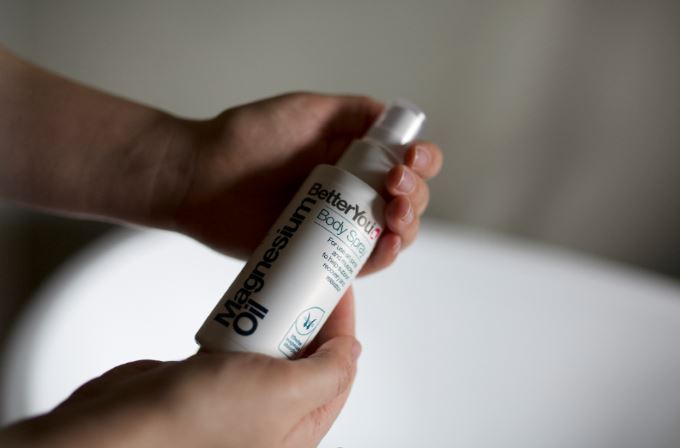Your body needs 16 essential minerals to be able to perform its functions in an optimal manner, magnesium is one of these minerals.
It plays a key role in more than 300 enzymatic reactions inside your body, with major benefits in calcium absorption, bone formation and maintenance of healthy heart muscles.
Our goal is to help your body achieve healthy levels of magnesium through transdermal magnesium. Our magnesium supplements include bath flakes, sprays, lotions, creams, and gels.
To give a clearer idea of our technology, let's begin by explaining what transdermal means.
What does transdermal mean

Transdermal is a term used to describe a method of application where the active ingredient travels through the skin to reach the blood for distribution all over the body.
If you're familiar with nicotine patches for smokers, that's actually how they work.
You may be wondering how these compounds travel through the skin—the most common route is called the intracellular pathway. This means that the active ingredients pass through the small spaces between the cells of your skin to get to the blood vessels and into the bloodstream. The blood then carries these compounds to where they need to go.
So what are the differences between the terms ‘transdermal’ and ‘topical’?
Many people confuse both terms, but transdermal and topical routes of administration are very different. While transdermal gels, sprays, and creams deliver active ingredients to the bloodstream, topical ones are meant to work locally where you apply them only.
Topical products are formulated to affect the skin itself without reaching the bloodstream to avoid systemic effects.
As for transdermal versus oral administration routes of medicine, they both offer systemic absorption and distribution via the bloodstream to various body tissues and organs.
The advantage of adopting the transdermal route over the conventional oral pathway is avoiding the unwanted first-pass effect of metabolism in the digestive system. This is why transdermal administration allows for better bioavailability.
In a 2010 study published by the European Journal of Nutraceutical Research to determine the impact of transdermal magnesium treatment on serum levels and whole body calcium to magnesium (CaMg) ratios, researchers found an average increase of 59.5% in the cellular magnesium levels of 89% of participants after twelve weeks of treatment with 31% saturated magnesium chloride solution.
To achieve the same results via oral route using the same concentration of active ingredients, you'd have to undergo treatment for a period of 9 to 24 months.
Transdermal supplements are typically applied as patches or ointments on the skin to deliver the active ingredient into the blood circulation. They're widely adopted in long-term hormonal therapy, chronic heart disease, as well as for quitting smoking.
Transdermal magnesium FAQs
By now, you may be having a lot of questions regarding the absorption of magnesium through the skin, so let's answer some common ones:
Does magnesium absorb through the skin?
Yes, magnesium can get absorbed into the body through application of the mineral to the skin in the form of solutions, creams or oils containing magnesium chloride salt.

Does magnesium oil cause dry skin?
Magnesium oil is good for overall skin health, however it can sometimes dry out the skin as it is a natural salt based solution. Our lotions and body butters are combined with skin-kind ingredients to help boost skin. The products contain essential magnesium chloride with deeply rich, intensively moisturizing ingredients.
Why does magnesium oil sting the skin?
There's a couple of reasons why your skin may sting when you apply magnesium oil, but it's important for you to understand that this isn't an allergic reaction, simply because magnesium is already naturally found within the body and is crucial to maintain healthy functions.
Your skin stinging or tingling may be the result of:
- low levels of cellular magnesium
- the movement of large magnesium molecules as they're rapidly absorbed across the epidermis
- application of too much magnesium oil per area
- applying the magnesium oil on very dry or broken skin
Can magnesium cause a skin rash?
Taken in correct doses, magnesium doesn't cause any form of skin allergies, including a skin rash.
It's also extremely rare for magnesium to cause allergic reactions with an overdose of transdermal supplements since the body actively eliminates excess amounts.
Plus, overdosing side-effects are mainly related to oral administration that can cause laxative effects.
What does magnesium do for skin?
Magnesium offers numerous positive effects on the skin since it's involved in hundreds of biochemical processes within your body.
Magnesium benefits for skin include the following:
- Enhanced skin elasticity and hydration
- Antioxidant action against harmful free radicals
- Delaying the appearance of wrinkles and fine lines
- Soothing effects for redness in skin
- Promotes a younger and healthier look
Can too much magnesium cause itchy skin?
Magnesium may cause an itch because of the absorption dynamics, applying too much product per area, or applying the product directly over broken skin. It's never an allergic reaction.
Again, suffering from side-effects due to severe overdose of magnesium is extremely rare in individuals with healthy kidneys.
Moreover, the most common signs of an overdose are nausea, vomiting, and stomach upset. All are risks of oral administration, not transdermal.
Does magnesium help skin?
Yes, as we mentioned above, magnesium can help with skin problems such as wrinkles, fine lines, dryness, inflammation and redness.
How much transdermal magnesium should I use?
According to Government Dietary Recommendations, the amount of magnesium your body needs per day is:
- 300 mg for males aged 19 to 64 years
- 270 mg for females aged 19 to 64 years
However, it is important to note that there is no upper tolerable limit for transdermal magnesium.
Is transdermal magnesium better than oral?
Transdermal magnesium is ideal for individuals who struggle taking tablets. It absorbs quickly and effectively into the skin, and uses a pure form of magnesium chloride. Transdermal magnesium is also ideal if you have digestive issues when taking supplements, as it enters the body quickly, bypassing the digestive system.
Magnesium Flakes

The bestselling product in our magnesium range, Magnesium Flakes can offer an efficient solution to raising your levels from the comfort of your bath.
Magnesium bath flakes, also known as magnesium bath salts, are designed to be added to your bath or footbath. It's a highly concentrated form of magnesium supplementation, containing 47% magnesium chloride salt derived from a natural source below the earth's crust.
Magnesium flakes offer the ultimate relaxation time for your body to help soothe aching and fatigued muscles, all the while providing effective magnesium absorption.
For your bath, add 2 cups of Magnesium Flakes per bath. Lie and relax in the water for at least 20 minutes.
For your footbath, add 1 cup of Magnesium Flakes to approx. 5 liters of water, enough to cover the feet. Sit and enjoy it for 20 minutes.
A magnesium bath is recommended 2 to 3 times a week.
Dosage: 35oz (1kg) of Magnesium Flakes contains 120g of elemental magnesium.
Click this link for more on magnesium flakes
Click this link for information on the difference between flakes and Dead Sea salts
Magnesium Sprays
Magnesium oil sprays are also a very popular option that you can use for general magnesium intake, joint therapy, muscle recovery, and sleep enhancement.
Magnesium sprays are easy to apply anytime throughout the day. The best time, however, is following a warm bath or shower while your skin pores are open to boost absorption.
The general recommended application is to spray between 5 and 10 sprays around the body then massage the solution into the skin to stimulate absorption – little and often is key. A 100ml spray bottle contains 600 sprays, lasting you about 100 to 120 applications.
Click this link for more on magnesium sprays
Original Magnesium Oil Body Spray

The original body spray is our most popular spray and it also happens to be the most effective in terms of saturation. It contains 31% magnesium chloride hexahydrate.
The original BetterYou Magnesium Oil Body Spray promotes natural muscle recovery, supports and improves calcium absorption.
Dosage: 10 sprays deliver of the original body spray provides 200mg (57% NRV) of optimally absorbable elemental magnesium.
Magnesium Sleep Body Spray

As you can tell from its name, this body spray works to soothe the senses and calm the body for a restful sleep. It contains 28% magnesium chloride hexahydrate, lavender and chamomile.
Dosage: 10 sprays deliver of the body spray provides 75mg of optimally absorbable elemental magnesium.
Magnesium Lotions
Magnesium creams and lotions, also including creams and butter, are similar to sprays in terms of benefits and application techniques. They're simple and quick to use, with effective magnesium absorption across the collection.
Generally, you should apply 5ml (4 pumps) of product around your body and follow up with a thorough massage into your skin to boost absorption. The best time to apply lotions, creams, and butter is after a warm bath or shower while your pores are open.
A 180ml bottle of magnesium lotion (or butter) should last you for 36 applications.
Magnesium Sleep Lotion
Magnesium Sleep Lotion is a soothing blend aiming to relax your muscles, relax your mind, and help you get better sleep. It contains magnesium chloride, lavender oil, and chamomile oil.
Dosage: 5ml of Magnesium Sleep Lotion delivers a minimum of 120mg of optimally absorbable elemental magnesium.
Magnesium Sleep Lotion Junior

Designed for children aged 1 years and above, this lotion works to provide a restful night's sleep for your little ones with the same combination of magnesium chloride and essential oils to relax and benefit the body.
Dosage: 5ml of Magnesium Sleep Lotion Junior delivers a minimum of 37mg of optimally absorbable elemental magnesium.
Further Reading & Resources
https://us.betteryou.com/pages/transdermal-magnesium
https://us.betteryou.com/pages/evidence-transdermal-magnesium-absorption
https://betteryou.com/health-matters/wp-content/uploads/2017/04/Watkins-Josling-magnesium.pdf
https://betteryou.com/blogs/product-guides/magnesium-flakes-what-they-are-and-how-they-can-help-you
https://betteryou.com/blogs/product-guides/magnesium-flakes-vs-epsom-salts-whats-the-difference




